Northern Arizona Spring Merriam's Turkey Hunts
Arizona Merriam's Turkey Guides and Outfitters
Hunt Native Merriam's Gobblers
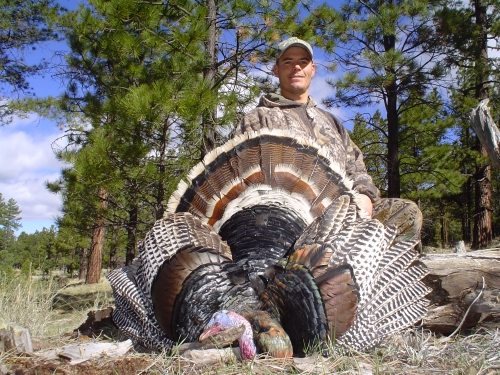
![]()
About the Northern Arizona Merriam's Wild Turkey
Northern Arizona is home to the Merriam’s wild turkey, whereas southern Arizona is where the Gould's turkey resides. Historically, the Merriam's turkey was only found in 3 states: Arizona, New Mexico, and Colorado. Merriam's have been transplanted from these three states to many parts of the country, but a unique place to hunt them is in their indigenous area. Arizona turkeys are wild and native birds. This is where the Merriam's originated, so they are pure. There is no hybridization in our areas like some other areas of the country that offer Merriam's turkey hunting.
Characteristics: The bright colors of the Arizona Merriam's turkey will amaze hunters that are only familiar with the other turkey subspecies. Merriam's have a cream-white accent on the outer edge of the tail feathers and rump, unlike the Eastern, Osceola, and Rio Grande turkeys (Gould's typically have pure white). It's light colored tail tips are an intermediate between the tan Rio's and the white Gould's. The primary wing feathers are mostly white with small black accent bars (the opposite is true with the wing barring on the other 3 sub-species).
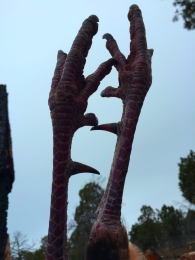 Mature
Arizona Tom Merriam's Turkeys grow beards averaging 9 inches,
although we have taken several exceptional birds with 11-inch
beards. Since the terrain is rough and
rocky, the spurs are typically worn or rounded. They usually do not
exceed 1¼ inches. Three-quarter to one-inch worn spurs are the norm
on mature 2 to 5+ year old mountain Merriam's. The size of these
Merriam's wild turkeys are BIG, averaging over 21lbs.
Typically, the mature Toms we harvest will weigh from 19 to
24 pounds! That's a large turkey considering there are no food
plots, no farm fields or other human feeding. Another interesting
feature, the native Merriam's tail fan is larger than the other three U.S.
wild turkey subspecies in the Grand Slam. These are just a few
common features among "true" Merriam's. If you want a real
native Merriam's turkey with no hybridization that shows pure traits, come
hunt with us in their native, indigenous mountain habitat of
northern Arizona.
Mature
Arizona Tom Merriam's Turkeys grow beards averaging 9 inches,
although we have taken several exceptional birds with 11-inch
beards. Since the terrain is rough and
rocky, the spurs are typically worn or rounded. They usually do not
exceed 1¼ inches. Three-quarter to one-inch worn spurs are the norm
on mature 2 to 5+ year old mountain Merriam's. The size of these
Merriam's wild turkeys are BIG, averaging over 21lbs.
Typically, the mature Toms we harvest will weigh from 19 to
24 pounds! That's a large turkey considering there are no food
plots, no farm fields or other human feeding. Another interesting
feature, the native Merriam's tail fan is larger than the other three U.S.
wild turkey subspecies in the Grand Slam. These are just a few
common features among "true" Merriam's. If you want a real
native Merriam's turkey with no hybridization that shows pure traits, come
hunt with us in their native, indigenous mountain habitat of
northern Arizona.
This is arguably the most beautiful sub-species of the Turkey Grand Slam and every Grand Slam hunter should add a "pure" Arizona Merriam’s to his collection!
We also offer southern Arizona Gould's Turkey Hunts.
![]()
About Our Arizona Spring Merriam's Turkey Hunts
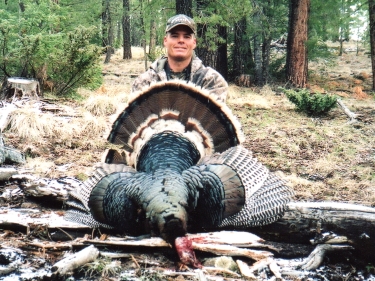 The
turkeys we hunt are primarily in remote areas and live many miles
from human civilization. Unlike Nebraska or other transplant States,
these are truly "wild turkeys." They live in their natural forested,
mountain habitat with no food plots, no farm fields, no feeders or
other human influence. Since Merriam's are mountain dwelling
turkeys, our hunts take place in the Ponderosa Pine forests at
elevations around 6500 to 8500 feet. The mountainous hunt area has
breathtaking scenery and great temperatures of around 75 degrees in
the day and 40 degrees at night. Arizona Shotgun Spring Season Merriam's turkey tags are
on a lottery draw. We typically hunt for northern Arizona Merriam's turkey
within public land, such as the Coconino National Forest.
The
turkeys we hunt are primarily in remote areas and live many miles
from human civilization. Unlike Nebraska or other transplant States,
these are truly "wild turkeys." They live in their natural forested,
mountain habitat with no food plots, no farm fields, no feeders or
other human influence. Since Merriam's are mountain dwelling
turkeys, our hunts take place in the Ponderosa Pine forests at
elevations around 6500 to 8500 feet. The mountainous hunt area has
breathtaking scenery and great temperatures of around 75 degrees in
the day and 40 degrees at night. Arizona Shotgun Spring Season Merriam's turkey tags are
on a lottery draw. We typically hunt for northern Arizona Merriam's turkey
within public land, such as the Coconino National Forest.
These are fully-guided turkey hunts. Hunters are led into the field daily by an experienced Merriam's turkey guide in order to provide the highest chances for success. Our guides are very familiar with the area, terrain, where the birds hang-out, and more importantly, the techniques needed to effectively hunt native mountain Merriam's turkeys. We conduct 1-on-1 and 2-on-1 turkey hunts, but to increase odds of harvesting, each hunter should consider having their own guide. If choosing 2-on-1, it is a requirement that you bring the other hunter to share the guide with. If you cannot find a hunting partner, you will have your own personal guide and get the 1-on-1 rate. We keep camp sizes to a minimum to ensure the utmost quality of the hunting experience.
Since Arizona is such a vast and arid (dry) environment, these native Merriam's turkeys tend to have a very large home range and are more spread-out than other turkeys. These birds live in the mountains with large canyons. Therefore, hunters should be prepared for hiking away from the road and into the prime turkey habitat. Primarily, we walk large ridges and set-up when we strike a gobbler. We also set-up in known corridor areas and "cold call" in blinds or against pine trees to see if a weary gobbler will come to investigate. Calling birds off the roost in the early morning can sometimes be effective, if the birds aren't henned-up. The guide will typically call for the hunters, but experienced turkey hunters can join-in with calling as well. If you are looking for a very original turkey hunt in a challenging remote setting where you will be hiking and hunting native, indigenous mountain birds, than this is the Merriam's hunt for you!
The outfitter also offers limited draw Gould's turkey hunts in southern Arizona. If you are looking to complete your Royal Slam without going to Mexico, southern Arizona is just about your only option for a U.S. Gould's gobbler. Visit the Gould's page or contact the outfitter for more details on Arizona Gould's turkey hunts.
![]()
Turkey Draw Info
Arizona shotgun turkey hunting is on a random lottery draw through the Arizona Game and Fish Department. Hunters that are interested in booking a hunt with us can be emailed general instructions on how to apply and which hunt numbers to use. The online draw application period for Spring Turkey is late September through early October. If you apply and are lucky enough to draw a tag, we would then book the hunt. As with any lottery draw, persistance is the key. Some hunters are lucky and draw after only 1 or 2 tries, while most are not so lucky and take longer to draw. You never know when you will be drawn, but you can build bonus points to increase your odds. Each time you apply and are not drawn, you receive a bonus point. An additional turkey bonus point can also be obtained in late May instead of applying for fall season Merriam's turkey. Therefore, 2 turkey points can be accumulated per year. For each turkey point you have, you get an additional entry into the draw, thus increasing your odds over time. It is currently averaging 5 bonus points for a non-resident to draw Merriam's in our preferred area. If you would like to hunt with us for turkey, Contact the Outfitter so he can point you in the right direction on how to apply for the draw and which hunt numbers to use on the lottery draw application.
2025 Arizona Spring Merriam's Turkey Season
Shotgun Spring Season: April 25 - May 15; Shotgun Spring Merriam's tags are by random lottery draw, apply in early Oct.
Arizona Licenses and Turkey Permit Tags
Hunting License Fees: $37 (Resident) or $160 (NonResident)
Turkey Permit Tag Fees: $38 (Res) or $105 (NonRes)
Since Arizona Shotgun Turkey hunting is on a random lottery draw basis. Once a tag is drawn for our preferred area, we would then book the hunt with a signed contract and 50% nonrefundable deposit. Primarily we apply for Merriam's turkey within the Coconino National Forest. Please contact us for details and instructions before applying.
Bag Limit: The bag limit in Arizona is ONE turkey per year; either a Merriam's or a Gould's, not both.
![]()
2025 HUNT RATES
FOR MERRIAM'S TURKEY
| TURKEY Hunt Options | # DAYS | RATE |
| Guided Merriam's Turkey Hunt (2-on-1) | up to 3* | $2,200.00/person |
| Guided Merriam's Turkey Hunt (1-on-1) | up to 3* | $2,500.00/person |
Non-Hunter Fee: Some hunters like to bring another person to camp and share the experience while they hunt. There might be an option to invite one person as a non-hunter or observer while on your guided turkey hunt. Non-hunter space is very limited. Based upon availability. Turkey Hunt Non-Hunter Fee: $800.00
Choose a "Hunter to Guide Ratio" of either 1-on-1 or 2-on-1. The 1-on-1 hunt means one hunter per guide. 2-on-1 means two hunters per guide (share a guide). In order to increase odds, we recommend each hunter have his own guide (choosing 1-on-1). If choosing 2-on-1, it is a requirement that you bring the other hunter to share the guide with. They must have also drawn a tag. If you cannot find a hunting partner or your partner was not drawn for a tag, you will have your own personal guide and get the 1-on-1 rate.
Description of Turkey Hunts
Spring Merriam's Turkey Hunts Include: Complimentary camp accommodations (primarily remote tent camps), complimentary meals, a guide, trophy prep (skinning/caping), up to 3 days of hunting (depart camp about noon on last day of hunting).
Costs and Considerations that are the hunter's responsibility: licenses and tags, transporting yourself to/from the camp, rental vehicle, taxidermy, transporting of animal to your home, airport hotel stay before/after the hunt (if flying). Gratuity for your guide is gladly accepted and customary (15% is typical).
* Arrive to camp the day prior to hunting. Depart camp about noon on the last day of hunting. So, it's best if flying non-resident hunters arrive in Arizona the evening prior to meeting us (two days before hunting), rent an SUV from the airport, get a hotel room and we will meet the next day about noon in the hunt area about 4 hours from Tucson Airport or 2.5 hours from Phoenix Airport. These are the closest major airports. Some hunters fly into Flagstaff, which is only 1 hour from the hunt area. Flying hunters can follow us to camp with their rental vehicle. Flights should depart the day after the hunt. More details on the general info page.
 Accommodations:
Our complimentary accommodations are basic southwestern
style outfitter tent camps which are often located many miles from
civilization. Sleeping quarters for turkey hunts are typically in
deluxe outfitter tents, unless noted otherwise. If you are looking for a hunt with fancy lodges, this is NOT the hunt for you!
Tent camps are used because we stay in remote areas. The
deluxe tents consist of large outfitter Kodiak Canvas brand tents. The size of our tents are tall and spacious
inside; typically 10X10 or 10X14 and stand 6.5 feet tall. The tents
are equipped with heaters during the colder months. Cots with thick
pads are provided, but all hunters must bring their own sleeping
bags. For those that own a camping trailer and would like to bring
it to camp to stay in are more than welcome to do so, but it must be short and high
enough for ground clearance on rough, rocky dirt roads. Please ask for road
conditions before bringing one.
Video of our typical
camp.
Accommodations:
Our complimentary accommodations are basic southwestern
style outfitter tent camps which are often located many miles from
civilization. Sleeping quarters for turkey hunts are typically in
deluxe outfitter tents, unless noted otherwise. If you are looking for a hunt with fancy lodges, this is NOT the hunt for you!
Tent camps are used because we stay in remote areas. The
deluxe tents consist of large outfitter Kodiak Canvas brand tents. The size of our tents are tall and spacious
inside; typically 10X10 or 10X14 and stand 6.5 feet tall. The tents
are equipped with heaters during the colder months. Cots with thick
pads are provided, but all hunters must bring their own sleeping
bags. For those that own a camping trailer and would like to bring
it to camp to stay in are more than welcome to do so, but it must be short and high
enough for ground clearance on rough, rocky dirt roads. Please ask for road
conditions before bringing one.
Video of our typical
camp.
![]()
Additional Information
Booking Info: A minimum 50% non-refundable deposit and some signed paperwork is required to book the hunt. General Spring Season hunters will book the hunt only after tags are drawn. The remaining balance is due at least 21 days prior to the hunt. We recommend cancellation insurance for all of our guests. Visit our policy page for more details on booking and cancellations.
Non-Hunter Fee: Some hunters like to bring another person to camp and share the experience while they hunt. There might be an option to invite one person as a non-hunter or observer while on your guided turkey hunt. Non-hunter space is very limited. Based upon availability. Turkey Hunt Non-Hunter Fee: $800.00
Camo Pattern: Hunting attire (clothes, vests, packs) must be fully camouflaged. We hunt Ponderosa Pine forests, which are primarily dark brown, green and dark gray/black in color. Therefore, the best camo patterns for our areas are Realtree, Mossy Oak , Kuiu Verde or any camouflage with drab colors. Face nets/masks and gloves are required.
Weapons: It is Arizona law that only shotguns, crossbows, or bows be used for turkey.
-
Shotgun Pattern: It is recommended that you pattern your shotgun prior to arrival. Patterning is well worth the time and money, considering how much is spent on turkey hunting. Buy a few different boxes of shells to see which loads produce the most hits or tightest pattern. It is proper hunter ethics to have a very tight pattern so that you either "put down" that Tom or miss his head/neck completely. The wider the pattern, the higher the risk of only hitting the bird in the body, thus crippling him. Nobody wants to see a trophy Tom get away injured, knowing he'll only die later in the woods.
-
Crossbows and Bows: Archery turkey hunting is the ultimate challenge, but the Crossbow Craze is quickly gaining popularity. It is only legal to use a crossbow for turkey during the general (shotgun) season and NOT during an archery-only season (unless you obtain and possess a special crossbow permit for those who cannot physically shoot a bow). The outfitter recommends that bowhunters and crossbow hunters use a broadhead with a very large metal cutting edge. Using a 2"+ bladed mechanical broadhead, such as RAGE Turkey X-treme, is preferred, since the kill zone on a turkey is rather small. This broadhead is designed with meat hooks, which helps the arrow to stay in the bird! That way, if the turkey is hit poorly (or sometimes hit well but he flies across the canyon), there is a higher chance for recovery. Tip for archery/crossbow turkey hunters: After your bird is hit with an arrow, sit tight, be silent, and just let him expire. It's not wise to get up and chase that bird!
Shotguns: We recommend shotguns to be chambered in 12 gauge using 3" or 3-1/2" magnum loads. But, a 20 gauge 3" magnum will also do the job with the proper load/choke combo (like Indian Creek tube with #7.5 TSS). The best turkey shells we have found are loads with Tungsten shot, such as Hevi-shot, Federal TSS or Apex TSS. If you prefer lead, Winchester Long Beard XR #5 shot produces good long-range results. Chokes should always be "turkey choke tubes" in order to produce the tightest and most uniform patterns possible for your particular gun. Indian Creek brand turkey choke tubes have proven to produce superior patterns. A turkey choke tube paired with either Hevi-shot, Federal TSS, Apex TSS, or Winchester Long Beard XR produces excellent long range results, if the need arises!
Our Track Record: The outfitter does not just cycle a multitude of hunters through the camp. But rather, he keeps camp sizes to a minimum to ensure the utmost quality of the hunt. Over the past 25+ years, our Spring Merriam's turkey hunters have experienced a high shot opportunity with a great success rate. We are proud to say that many of our seasons have experienced a 100% success rate! Unfortunately, due to the nature of turkey hunting in the mountains, success during some seasons has been lower. Bad weather (particularly high winds), "henned-up" gobblers, the hunter's physical fitness level, or just missing the shot were the limiting factors for the unfortunate hunters. Putting all statistics aside, you can "rest-assured" that your guide will do his very best in helping you have an enjoyable hunting experience! Please feel free to contact our references and view testimonials.
About the Outfitter: Pat Feldt earned a Bachelor of Science in Renewable Natural Resources with a major in Wildlife Management from the University of Arizona, which adds to his credibility as a full-time outfitter. Even though he is a big game guide throughout the year, his true passion is turkey hunting. He can be considered a "turkey hunting fanatic" who has been pursuing wild turkeys his whole lifetime. Pat is very experienced in all calling methods and you'll see him using most types of calls while on the hunt. But, he prefers to use raspy mouth diaphragms coupled with friction pot calls. Pat is also a firm believer in the use of decoys to aid in enticing a gobbler (if given ample time to set one up). He has taken dozens of native mountain Merriam's gobblers himself and has taken all the subspecies in the Grand Slam, as well as completed the US Royal Slam. His Gould's turkeys were taken within Arizona. See some of Pat's personal turkey harvests.
![]()
Arizona Spring Merriam's Turkey Hunt Photos
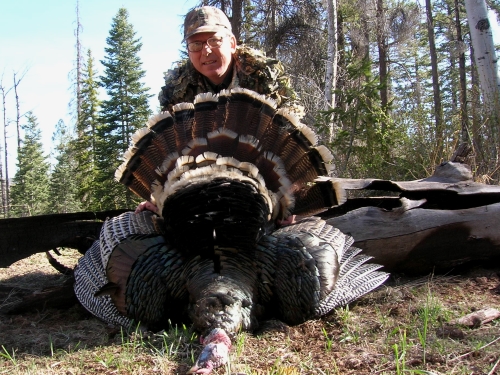
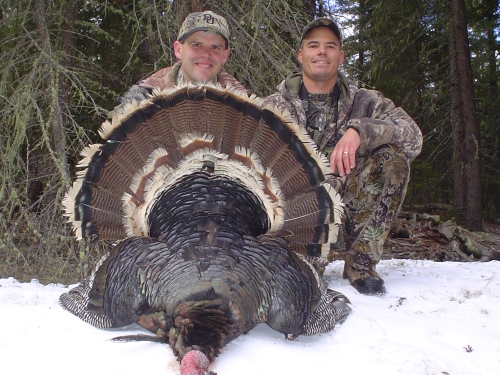
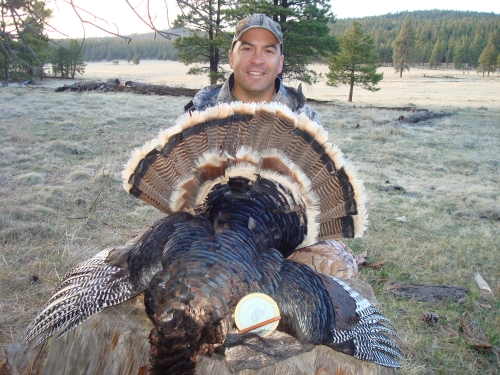
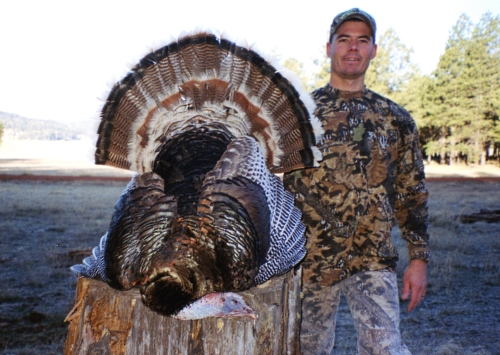
Also, be sure to view our general info page, list of items page, Gould's Turkey page, and references page.
We also offer Southern Arizona Gould's Turkey Hunts
![]()
Visit our favorite turkey hunting websites, the National Wild Turkey Federation and Wild Turkey Zone
